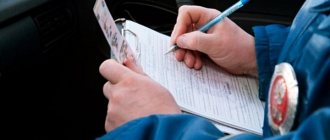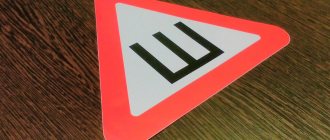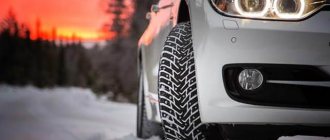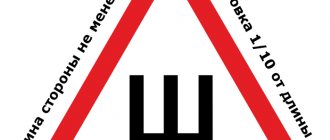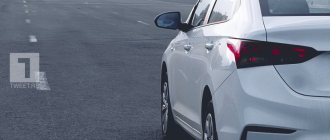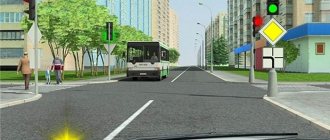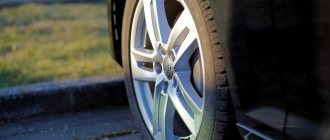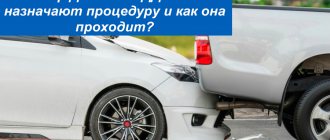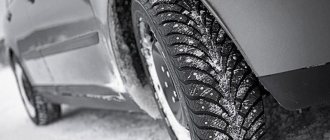Among the list of traffic rules identification signs, the “Spikes” sign was perceived ambiguously by drivers for a long time: the requirement to install it when using studded tires was not always considered mandatory. At the same time, studs have a significant impact on safety, and changes in traffic legislation could not fail to take this into account.
Until recently, the presence of the “Spikes” sign on cars with studded tires was mandatory, and its absence was subject to a fine of 500 rubles or a warning.
From December 8, 2021, the “Spikes” sign is excluded from the traffic rules (note – Government Decree No. 1414 of November 24, 2018). That is, now the presence of the “Spikes” sign on vehicles is not mandatory, and accordingly, a fine for its absence is no longer imposed.
However, there are quite good reasons why we recommend that drivers continue to mark their vehicles with the “Spikes” sign in the winter when driving on studded wheels. Below you will find answers to the following questions:
- Why was the mandatory use of the “Spikes” sign canceled?
- Why should you continue to use the “Spikes” sign?
- What size should the “Spikes” sign be and where is the best place to glue it?
- Additional information about the cancellation of the fine for the absence of the “Spikes” sign.
Why o?
When the “Spikes” sign was declared mandatory to designate cars with studded tires, the logic of the legislators was that a car with such tires brakes much more sharply. Therefore, the driver following you must be aware of your spikes in order to maintain a sufficiently large distance.
In fact, contrary to this logic, the braking distance of a car depends primarily on its weight, the presence of electronic safety systems and weather conditions. The mere presence or absence of studs on a tire, if it has any effect, is far from primary.
Perhaps 30 years ago the “Spikes” sign had some meaning, when everyone drove all-season tires and studs were quite rare. Then, probably, cars with spikes really braked noticeably sharper than all other cars. But nowadays this is no longer the case.
The “Spikes” sign has lost its original meaning, since today more than 70% of motorists, that is, the vast majority, drive studded tires. Therefore, if you need to mark some cars in traffic with winter tires, then it would be more logical to stick the sign on cars with Velcro rather than with studs.
Purpose
Changes regarding the mandatory installation of the “Ш” sign came into force only on April 4, 2021. Some drivers still do not know whether this requirement is a simple formality, or whether it is a mandatory condition for driving on the highway.
To the question “Is it possible to drive like this?” The answer is clear: no. According to the Traffic Regulations, clause 8 of the “Basic Provisions”, placing this warning sign on the car is mandatory.
Besides legal requirements, there are at least two reasons for this:
- installing such tires reduces the braking distance;
- The windshield behind moving vehicles may be damaged.
During the winter season, the quality and condition of the road surface changes significantly. The car sometimes becomes almost uncontrollable. To protect themselves and their loved ones, drivers should install winter studded tires.
Its presence significantly reduces the braking distance. This means that even in slippery road conditions the driver will be able to stop very quickly.
Installing the "Ш" sign serves as a reliable warning to following motorists. There is another reason why installing the "Ш" sign is mandatory. The fact is that studded tires are not always of the best quality.
When cars are moving at high speeds, such a piece of rubber can cause the same impact as a pebble hitting glass.
There are known cases when a driver who was guilty of an accident due to failure to keep a safe distance sued the innocent driver only because he did not place a warning sign about a sudden stop on his rear window. There is also a high risk that the insurance company may refuse legitimate payment.
Why then stick the “Spikes” sign on your car?
The use of studded tires in winter created not only safer and more comfortable conditions for drivers and passengers of such “re-shod” cars, but also certain problems for other road users, especially those driving behind.
The main danger from cars with “spikes” is small crushed stone, which can fly out from under the studded wheels and damage the car driving behind, or even injure the driver. And a spike flying out of a tire can also seriously damage the windshield.
It is for the reasons mentioned above that we recommend that all conscious drivers continue to mark their cars with the “Spikes” sign when using studded tires.
By the way, experienced motorists can recall cases when traffic police inspectors concluded that cars colliding “in single file” on a slippery road were mutually at fault only because the car ahead on spikes did not have the “Spikes” identification mark installed. And no appeals to the fact that the rear car did not keep the required distance helped.
Another thing is that the use of new technologies in the production of car tires has made it possible to create models of winter tires that are not only not inferior in braking efficiency to studded ones, but also superior to them in many situations (studs or Velcro - which is better?). Therefore, an increased distance to the car in front must be maintained by cars with spikes too.
Installation rules and dimensions according to standards
That is, driving without a “Spikes” sign on a car with installed studded winter tires is considered illegal from 2021. By the way, now everyone can easily identify a car by license plate using the current database.
As has already become clear, installing the “Spikes” sign on the rear window of cars is mandatory. It is noteworthy that the same paragraph of the rules also stipulates what size the sign should be.
To avoid troubles when communicating with traffic police representatives, it is worth considering all the rules from the beginning:
- the “Spikes” sign must be presented in the form of an equilateral triangle with a side of at least 20 cm;
- the width of the red outline should be at least 10% of the length of the side, this means that with a side of 20 cm, the thickness of the border should be 2 cm;
- the background for this warning sign must be white;
- the sign must be so distinct that it can be recognized from a distance of 20 meters;
- It is important to take into account that the sign can be read in the dark.
All these provisions are spelled out in the traffic rules “Basic provisions”, paragraph 2, second paragraph. The Road Traffic Regulations do not clearly state where exactly this identification mark needs to be affixed. The requirements include only a note that it should be “at the back”.
Although many drivers advise sticking the identification tag in the upper left corner of the rear window, it is worth considering that on some models the light will glare and the sign will not be visible.
We suggest you read: Where to submit a court order for the collection of alimony
There is no consensus on whether it is necessary to remove the sign when studded tires are not in use. Since the rules do not say anything about this, each driver decides for himself whether to remove this sign or not.
It is worth considering the periods when the use of studded tires itself is permitted and even mandatory, or, conversely, prohibited.
The article will tell you about the variety of tints:
Types of tints
.
Read about Chinese tinting here.
It is mandatory to use the winter kit from December to February. This is prohibited during the summer months, that is, from June to August.
The Rules say nothing regarding the off-season. Therefore, each driver decides for himself which tires to use depending on weather conditions.
What size should the “Spikes” sign be and where should it be placed?
Before the abolition of the mandatory use of the “Spikes” sign, with the beginning of the winter season in car dealerships, the stock of stickers with its image was often insufficient.
In this regard, the independent production of a sign was very relevant and many car enthusiasts needed information about the shape, size and color scheme of the sign.
- In accordance with the old version of the Road Traffic Rules, the “Spikes” sign is an equilateral triangle with the letter “W” inside it.
- The triangle is positioned with the apex up, and the length of the side is at least 20 cm.
- Along the sides of the triangle there is a border, the width of which is ten percent of the length of the side.
- Color scheme: the sign has a white background, a red border, and the letter “Ш” is black.
Where can I download the “Spikes” sign and how to print it correctly?
If you have the opportunity to use a color printer, then the “Spikes” sign can then be printed. It is advisable to do this on thick paper, for example, photo paper with a density of up to 150 g/m2, otherwise the sign will turn out to be short-lived.
If only a black and white printer is available, then we suggest, and the printout will need to be modified: use a brush with red paint or a red felt-tip pen to color the edge of the sign.
Where should the “Spikes” sign be placed?
The “Spikes” sign must be placed “behind” motor vehicles. Most often, it is glued in the upper corner of the rear window of the car on the inside - this place is convenient both for informing the driver driving behind and for ensuring the durability of the sign itself.
However, other installation locations do not contradict the traffic regulations, for example, on the bumper or on the rear trunk lid. Only in this case will the sign be exposed to precipitation and may quickly become unusable.
As for the use of a homemade “Spikes” sign of non-standard sizes, it should not be made smaller than the recommended minimum, but a significantly larger sign is also undesirable - when installed on the rear window, this may unacceptably restrict the driver’s visibility.
Where should I glue it?
In paragraph 8 of the Basic Provisions it is noted that the “Spikes” notification sticker may be located on the rear panel of the body or window of the car. The owner of the car determines the location of the marking element at his own discretion.
According to experienced driving school instructors, the light element with the image of the letter “W” is clearly visible from the upper corner of the rear window. If there is tinting, a sign warning about studded tires is glued to the outside. Transparent glass allows the placement of a marking element from inside the cabin.
This is interesting: The safest cars in the world and Russia: review for 2021
When replacing winter tires with summer tires, it is not necessary to remove the corresponding sticker. This situation is not considered an offense. However, every road user is obliged not only to comply with traffic rules, but also to treat other motorists with respect. In summer, it is recommended to remove the “Spikes” sign from the car.
On the abolition of the fine for the absence of the “Spikes” sign
Previously, the absence of the “Spikes” sign referred to malfunctions in which the operation of the car was prohibited. Therefore, the punishment for failure to comply with the requirement to install it was regulated by the relevant article of the Code of Administrative Offences:
| Article of the Administrative Code | The content of the article | Responsibility for violation |
| 12.5 part 1 | Driving a vehicle in the presence of malfunctions or conditions under which, in accordance with the Basic Provisions for the admission of vehicles to operation and the duties of officials to ensure road safety, operation of the vehicle is prohibited, with the exception of malfunctions and conditions specified in parts 2 - 7 of this article | Punishment: warning or administrative fine in the amount of five hundred rubles Cases are considered by: Internal Affairs bodies |
But since the current version of the traffic rules does not provide for the use of the “Spikes” sign, there is also no punishment for its absence.
By the way, in accordance with the Road Traffic Regulations, motorists are required to use winter tires from December to March. At the same time, by local legislation it can be either reduced or increased, because winter in Norilsk and Rostov proceeds differently.
Car enthusiasts often wonder whether the opposite situation is a violation: a “Spikes” sign installed on a car in the summer (more precisely, installed in the winter and not removed in the summer). The Rules do not say anything about installing a sign during a strictly defined period, and, therefore, this situation is not a violation, and there is no need to fear a fine. And the margin of distance that the driver driving behind will set in the presence of a sign will not hurt at all.
Why notify about studded tires?
Most regions of the Russian Federation are dominated by a harsh climate with frequent precipitation in the form of snow and heavy rains. Due to poor climatic conditions in the autumn-winter period, drivers are forced to install studded tires on their cars.
Car tires with metal studs improve vehicle cross-country ability in difficult weather conditions and prevent slipping on snow and ice-covered roads.
Not every motorist knows that studded tires pose a danger to all road users. Understanding and mutual respect on the road reduces the number of traffic accidents. The “Spikes” sign pasted on the body or rear window of the passenger compartment means that the car in front is equipped with tires with metal spikes.
The main reasons for installing a warning sticker include:
- Notifying traffic participants about the presence of studded tires on the vehicle ahead.
- Maintaining distance while driving. A car with studded tires has a shorter braking distance during emergency braking.
- Warning against possible damage. When driving at high speed, the number of wheel revolutions increases. Flying metal inserts can damage neighboring machines.
- Guilt in case of a traffic accident. The driver of a car moving in front with studded tires may be found guilty of an accident if the “Spikes” marking element was not installed on the car.
- Passing a technical inspection. The absence of the “Spikes” sign on a car with studded tires may result in refusal to issue a vehicle inspection ticket. Further use of the vehicle is prohibited.
This is interesting: Do-it-yourself valve grinding
The above-mentioned options for the development of various situations on the road can be costly for the car owner.
Other signs on the rear window
Many drivers don't like having to use stickers with signs that are difficult to remove. In fact, the “Ш” sign is not the only one that is required to be placed on a car.
According to the Traffic Regulations, Article 8 of the main provisions, 11 symbols are mandatory signs:
- Road train. Must be installed on trucks and tractors, as well as on buses and trolleybuses that are interconnected.
- Spikes. A white triangle with a red border, inside of which there is the letter “W”. Installed on the rear window of vehicles with studded tires.
- Transportation of children. Installed in specified cases. It can be removable, or it can be permanent if it is, for example, a bus engaged in such transportation.
- Training vehicle. The sign is installed on the window of the car the student is driving. Mandatory for vehicles used for training.
- Speed Limit. Signs are used for vehicles subject to speed limits. This may apply to cars carrying children and to those vehicles that have such a restriction due to technical features.
- Dangerous cargo. The identification mark has several types. It may vary depending on what type of cargo is being transported.
- Large cargo. The sign is covered with a reflective surface.
- Slow moving vehicle. Installed on cars for which the initially permissible speed does not exceed 30 km/h.
- Long vehicle. Installed on vehicles longer than 20 meters.
- Novice driver. Installed on cars driven by drivers with less than two years of experience.
- Signs “Doctor” and “Disabled” are installed at will.
We suggest you read: When pensions are assigned by law
When to put up a sign
The answer to this question lies on the surface: as soon as the car has changed into studded wheels, a corresponding warning sign should appear.
In this case, the problem may appear if the car gets into an accident during the off-season, that is, in the autumn or spring. After changes have been made to the traffic rules, car owners must change tires to ones that correspond to the season outside the window.
Thus, in the fall and spring it will not be clear whether the car is driving on summer wheels, if there is no sticker, or on studded wheels. As mentioned at the beginning, a car with winter wheels has a much shorter braking distance. If the person driving such a car resorts to emergency braking, at a short distance the driver of the car behind will not be able to react in a timely manner.
In such an accident, traffic inspectors can determine mutual fault:
- The owner of the vehicle in front did not notify other road users about the studded tires installed on the car.
- The second driver will be charged with failure to maintain a distance.
This situation can create a lot of headaches when contacting the insurance company for compensation. While the first court hearing is going on, then the option of an appeal is not excluded, then the second trial will begin.
To avoid unnecessary time costs, it is better to stick a warning triangle immediately after replacing it with studded tires, even before the deadline prescribed by law. Then people in uniform will have fewer additional questions.
